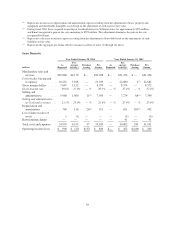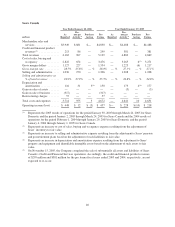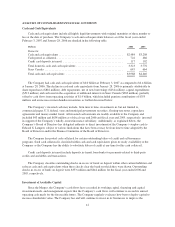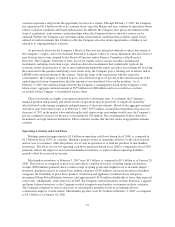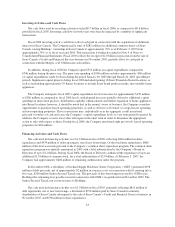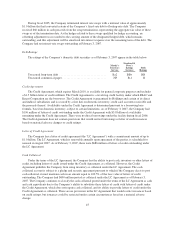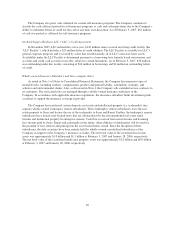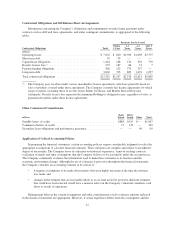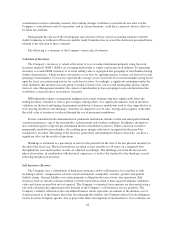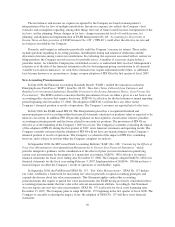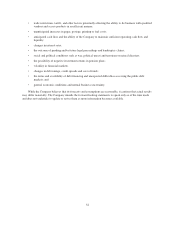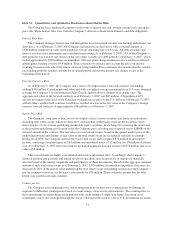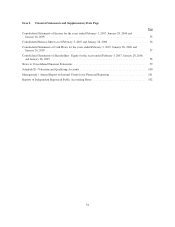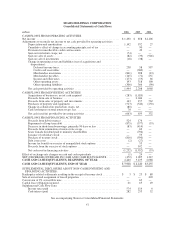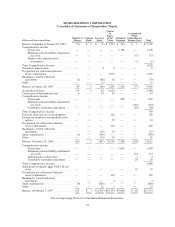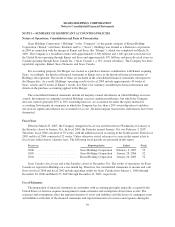Sears 2006 Annual Report Download - page 49
Download and view the complete annual report
Please find page 49 of the 2006 Sears annual report below. You can navigate through the pages in the report by either clicking on the pages listed below, or by using the keyword search tool below to find specific information within the annual report.adjusted based upon actual claims settlements and reported claims. These projections are subject to a high degree
of variability based upon future inflation rates, litigation trends, legal interpretations, benefit level changes and
claim settlement patterns. Although the Company does not expect the amounts ultimately paid to differ
significantly from its estimates, self-insurance reserves could be affected if future claim experience differs
significantly from the historical trends and the actuarial assumptions.
Defined Benefit Retirement Plans
The fundamental components of accounting for defined benefit retirement plans consist of the compensation
cost of the benefits earned, the interest cost from deferring payment of those benefits into the future and the
results of investing any assets set aside to fund the obligation. Such retirement benefits were earned by associates
ratably over their service careers. Therefore, the amounts reported in the income statement for these retirement
plans have historically followed the same pattern. Accordingly, changes in the obligations or the value of assets
to fund them have been recognized systematically and gradually over the associate’s estimated period of service.
The largest drivers of experience losses in recent years have been the discount rate used to determine the present
value of the obligation and the actual return on pension assets. The Company recognizes the changes by
amortizing experience gains/losses in excess of the 10% corridor into expense over the associate service period
and by recognizing the difference between actual and expected asset returns over a five-year period. The Sears
domestic pension plans had no unrecognized experience gain or loss as of the date of the Merger.
Effective January 31, 1996, Kmart’s pension plans were frozen, and associates no longer earn additional
benefits under the plans. Therefore, there are no assumptions related to future compensation costs relating to the
Kmart pension plans. During the first quarter of 2005, Holdings announced that the Sears domestic pension plan
would be frozen effective January 1, 2006. Accordingly, domestic associates have earned no additional benefits
subsequent to December 31, 2005. Benefits earned through December 31, 2005 will be paid out to eligible
participants following retirement.
Holdings’ actuarial valuations utilize key assumptions including discount rates and expected returns on plan
assets. The Company is required to consider current market conditions, including changes in interest rates and
plan asset investment returns, in determining these assumptions. Actuarial assumptions may differ materially
from actual results due to changing market and economic conditions, changes in investment strategies and higher
or lower withdrawal rates or longer or shorter life spans of participants.
Income Taxes
The Company accounts for income taxes in accordance with SFAS No. 109, “Accounting for Income Taxes”
which requires that deferred tax assets and liabilities be recognized using enacted tax rates for the effect of
temporary differences between the financial reporting and tax bases of recorded assets and liabilities. SFAS
No. 109 also requires that deferred tax assets be reduced by a valuation allowance if it is more likely than not that
some portion of or all of the deferred tax asset will not be realized.
During the first quarter of fiscal 2005, the Company recognized a reversal of approximately $1.1 billion of
its pre-Merger deferred income tax valuation allowance as a result of the Merger and the combined tax attributes
resulting from it. SFAS No. 109 requires that this reversal be included in the Company’s purchase accounting
adjustments as a reduction to goodwill attributable to the Merger. Given the Company’s current and forecasted
levels of profitability, as well as its ability to realize the deferred tax assets through tax strategies if necessary,
management believes that a significant portion of the deferred tax assets will more likely than not be realized.
The remaining consolidated valuation allowance as of February 3, 2007 is $332 million and relates to the
uncertainty around the realization of certain state deferred tax assets all of which are attributable to Sears. The
Company will continue to assess the likelihood of realization of these state deferred tax assets and will reduce the
valuation allowance on such assets in the future if it becomes more likely than not that the net deferred tax assets
will be utilized.
49


